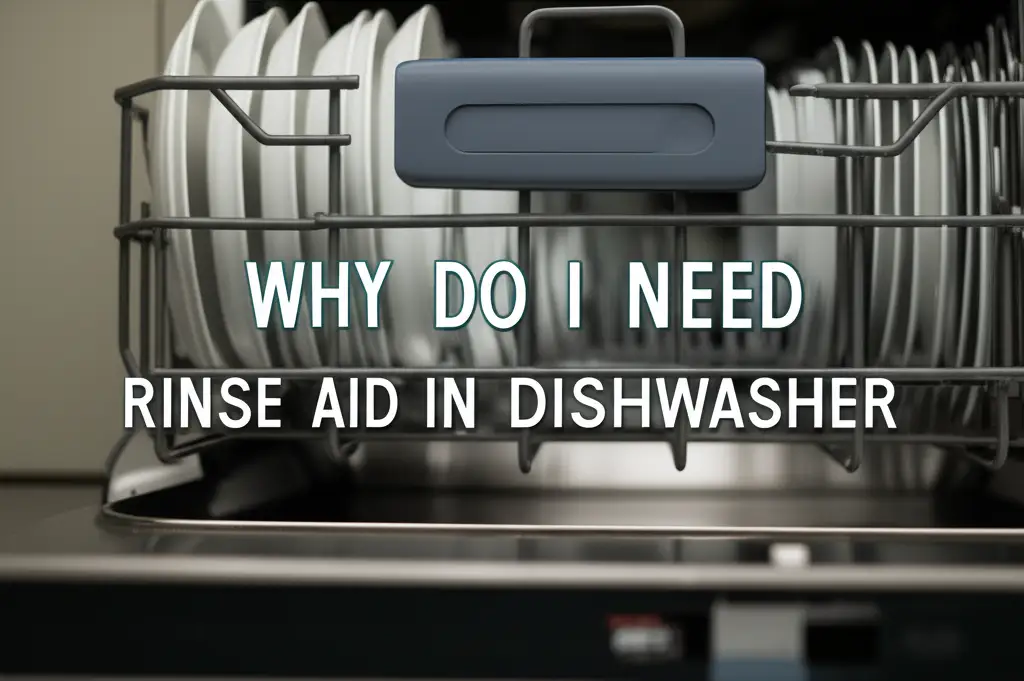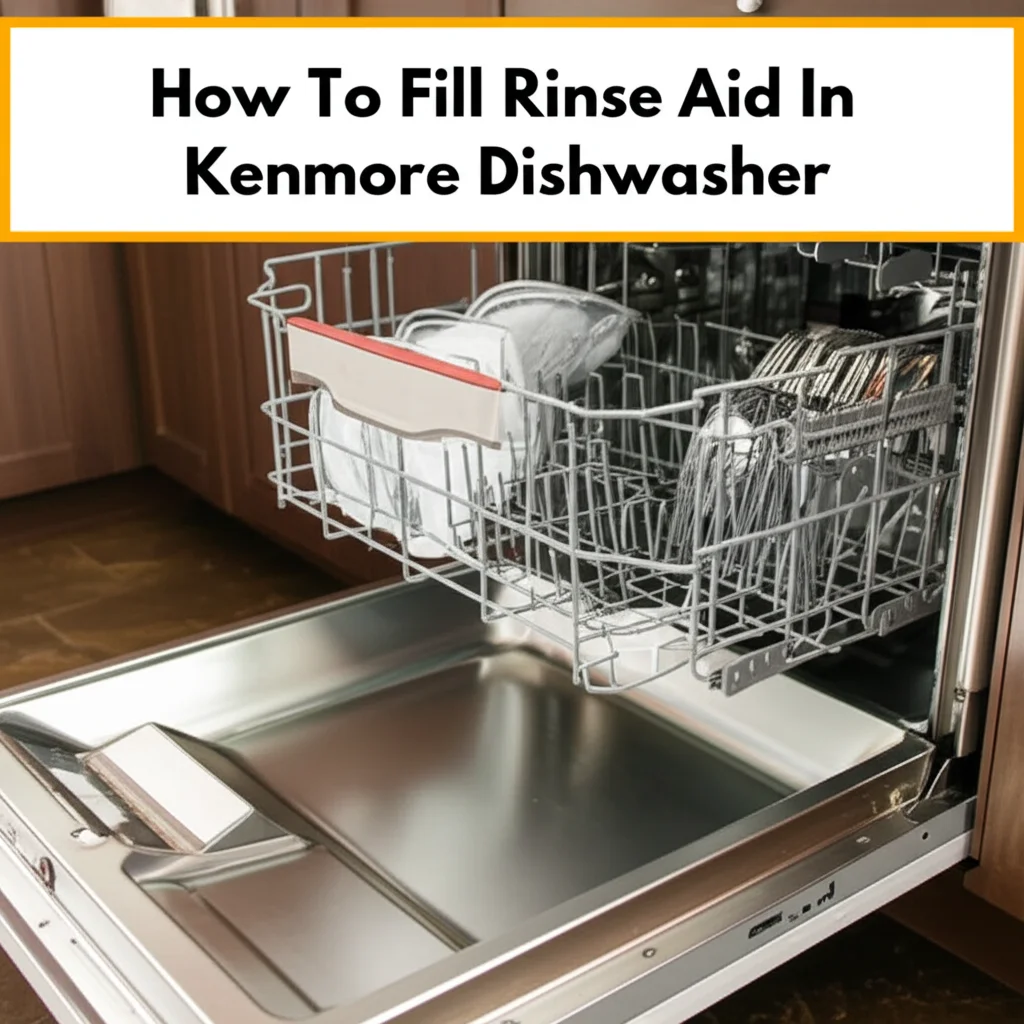· Katria Melrose · Kitchen Appliances · 15 min read
Why Do I Need Rinse Aid In Dishwasher

Why Your Dishwasher Needs Rinse Aid for Spotless Results
Have you ever unloaded your dishwasher, expecting sparkling clean dishes, only to find them covered in unsightly spots and streaks? It is a common frustration many of us face. You might wonder if your dishwasher is failing or if your detergent is not strong enough. The hidden hero you might be missing is rinse aid. This simple additive can transform your dishwashing results from cloudy to brilliantly clear. I once struggled with foggy glasses until I realized the power of this product.
In this article, I will explain why rinse aid is an indispensable part of your dishwashing routine. We will explore how it works to eliminate water spots and improve drying performance. You will learn about the science behind its effectiveness and the many benefits it offers. We will also cover how to choose and use rinse aid correctly. Finally, I will address common issues and provide clear answers to frequently asked questions. Get ready to achieve truly spotless dishes with every wash.
Takeaway
- Rinse aid prevents water spots and streaks by breaking water surface tension.
- It helps dishes dry faster and more completely.
- Rinse aid improves the shine of glassware and cutlery.
- It is different from detergent and works during the final rinse cycle.
- Regular use keeps your dishwasher working efficiently for sparkling results.
Why do I need rinse aid in my dishwasher? Rinse aid helps water sheet off dishes, preventing water spots and streaks, especially in hard water areas. It promotes faster drying by reducing surface tension, ensuring your dishes come out sparkling clean and dry every time. It is a key ingredient for truly spotless results.
The Science Behind Spotless Dishes: How Rinse Aid Works
You might think water just flows off dishes. However, water has a property called surface tension. This tension causes water to cling to surfaces in small droplets. When these droplets dry, they leave behind minerals, which appear as spots and streaks on your dishes. This is especially true if you have hard water in your area. Those pesky spots are often mineral deposits, not dirt.
Rinse aid acts as a surfactant. This means it reduces the surface tension of water. When rinse aid is released during the final rinse cycle, it helps the water spread out evenly. Instead of forming droplets, the water sheets off the dishes in a thin film. This action ensures that very little water remains on the surface. My own experience showed me how much difference this made for my glass tumblers.
This sheeting action is crucial for several reasons. First, it prevents the water from collecting and drying in concentrated spots. This means fewer mineral deposits are left behind. Second, with less water clinging to the dishes, they dry much faster. This speeds up the drying process, whether your dishwasher uses heat or air drying. It also reduces the need for towel drying, which can introduce lint.
Without rinse aid, water clings to dishes. These remaining water spots are very visible on glass and shiny surfaces. Rinse aid makes sure water rolls right off. It creates a smooth, clear finish. This is the secret to getting truly sparkling dishes and glassware from your machine. It is a simple chemical process that yields big results.
Beyond Spots: The Many Benefits of Using Rinse Aid
Using rinse aid offers more than just preventing water spots. It significantly improves the overall performance of your dishwasher. One major benefit is faster drying. Dishes come out of the dishwasher drier, which means less time waiting for items to air dry or manually wiping them down. This is very convenient for busy households.
Rinse aid also leaves your dishes with a brilliant shine. Glasses appear crystal clear, and cutlery gleams. This is because the water runs off cleanly, taking mineral residues with it. You will notice a visible difference in the clarity and brilliance of all your dishware. It truly makes your dishes look professionally cleaned.
Furthermore, rinse aid can help prevent etching and cloudiness on glassware. Over time, hard water and detergent residues can cause a permanent cloudy film on glasses. Rinse aid helps to wash these residues away completely. This protects your delicate glassware, preserving its shine and extending its lifespan. I have seen how my older glasses benefited from consistent rinse aid use.
Another subtle benefit is improved hygiene. When dishes dry more completely, there is less chance for bacteria to grow in residual moisture. This ensures your dishes are not only visibly clean but also more sanitary. It supports a cleaner kitchen environment. Rinse aid works in the background to ensure every wash cycle ends with optimal results.
Common Dishwasher Problems Rinse Aid Solves
Many common dishwasher problems can be traced back to a lack of rinse aid. If your dishes often come out with visible streaks, spots, or a cloudy film, rinse aid is likely the solution. These issues are almost always caused by water drying on the dishes, leaving mineral deposits behind. This is especially true if you live in an area with hard water. Hard water contains high levels of minerals like calcium and magnesium, which are the main culprits for spotting.
Rinse aid is designed to combat these mineral residues directly. It helps the water slide off completely, taking those dissolved minerals with it. Without rinse aid, hard water can leave a stubborn film on glasses and cutlery. This film can make otherwise clean dishes look dirty and unappealing. You might even find yourself rewashing items by hand, which defeats the purpose of having a dishwasher.
Another issue rinse aid helps with is poor drying performance. If your dishes are still wet or damp after a cycle, it is a sign that water is clinging to the surfaces. Rinse aid promotes rapid drying by encouraging water to sheet off. This means you do not have to hand-dry your dishes, saving you time and effort. It ensures your dishes are ready to put away as soon as the cycle finishes.
Sometimes, people try to solve these problems by using more detergent or washing dishes multiple times. This often does not help and can even create more residue. The correct solution is often simply adding rinse aid. It is a targeted solution for specific water-related issues that detergent alone cannot fix. If you are experiencing these frustrating issues, it is time to check your rinse aid dispenser. If you notice your dishwasher isn’t performing as it should without rinse aid, you might even consider options like learning how to run LG dishwasher without rinse aid if you’re trying to troubleshoot drying issues specific to your model.
Choosing the Right Rinse Aid and How to Use It
Selecting the right rinse aid for your dishwasher is straightforward. Most rinse aids are universal and work well with any dishwasher brand. You will find them in liquid form, often near dishwasher detergents in stores. Popular brands include Finish, Cascade, and Somat. Some modern detergents also contain a built-in rinse aid. However, I find that a separate liquid rinse aid often provides superior results, especially with hard water.
How to Fill Your Dishwasher’s Rinse Aid Dispenser
Filling the rinse aid dispenser is a simple task. My experience showed me it’s easier than I thought.
- Locate the Dispenser: The rinse aid dispenser is usually found on the inside of your dishwasher door, next to the detergent dispenser. It often has a cap that you can twist or lift.
- Open the Cap: Carefully open the dispenser cap. It might be clearly labeled as “rinse aid” or have a star-like symbol.
- Pour the Rinse Aid: Pour the liquid rinse aid into the dispenser opening. Fill it up to the “max” line, but do not overfill it. Overfilling can lead to too much rinse aid being dispensed, causing excessive suds.
- Close the Cap: Securely close the dispenser cap. You should hear a click or feel it seal tightly. This prevents leaks during the wash cycle.
Many dishwashers also allow you to adjust the rinse aid dosage. If you see spots, increase the setting. If you see streaks, decrease it. Consult your dishwasher’s manual for specific instructions on adjusting the dose. For instance, if you have a Whirlpool model, knowing how to fill rinse aid on Whirlpool dishwasher can ensure you do it correctly every time. If you have a Bosch, there are specific instructions too. You can learn how to fill Bosch dishwasher with rinse aid to make sure you get the best results.
Remember to check your rinse aid dispenser regularly. Most dishwashers have an indicator light that tells you when it is low. This light will help you remember when to refill it. Consistent use is key to enjoying perfectly spotless and dry dishes.
When to Refill and Troubleshooting Rinse Aid Issues
Knowing when to refill your rinse aid is important for continuous sparkling results. Most modern dishwashers have a rinse aid indicator light on the control panel. This light typically illuminates when the rinse aid level is low, prompting you to refill the dispenser. Do not wait until the light comes on during a cycle; refill it promptly. If you are ever curious why is the rinse aid light on dishwasher, it is usually just telling you it is time for a top-up. Some dishwashers might have a clear window on the dispenser itself, allowing you to visually check the level. I always give mine a quick look before starting a big load.
Sometimes, you might encounter issues even with rinse aid in the dispenser. Here are some common troubleshooting tips:
- Dishes Still Have Spots/Streaks:
- Check Dispenser Level: Ensure the dispenser is full. Even if the light is off, it might be low. You need to know when rinse aid is empty to prevent these issues.
- Adjust Dosage: Your dishwasher might be dispensing too little rinse aid. Consult your manual to increase the dosage setting. Harder water often requires a higher dose.
- Expired Rinse Aid: While rare, old rinse aid might lose effectiveness. Replace it with a fresh bottle.
- Water Hardness: If your water is extremely hard, you might need a water softener in addition to rinse aid.
- Too Many Suds/Rainbow Sheen:
- Overfilling Dispenser: You might have poured too much rinse aid into the dispenser. This can cause excess suds. If this happens, you might need to figure out how to get rinse aid out of dishwasher to correct the issue.
- Dosage Too High: Your dishwasher might be dispensing too much rinse aid. Adjust the dosage setting down.
- Using Too Much Detergent: Excessive detergent can also contribute to suds.
- Rinse Aid Light Stays On:
- Sometimes, even after refilling, the light remains on. This can be a sensor issue. Try running a cycle or two. If it persists, consult your dishwasher’s manual or a service technician. It’s frustrating when my rinse aid light is still on, but a quick check often reveals the cause.
Consistent monitoring and occasional adjustments will ensure your dishwasher always delivers its best performance. Do not be afraid to experiment with the dosage to find the perfect setting for your water conditions.
Rinse Aid vs. Detergent: Understanding the Difference
It is easy to confuse rinse aid and dishwasher detergent, but they serve distinct purposes. Think of them as two separate tools working together for one goal: sparkling clean dishes. Detergent is the primary cleaning agent. Its job is to break down food particles and grease. It contains powerful cleaning chemicals that scrub your dishes during the main wash cycles. You add it at the beginning of the wash, and it foams up to dissolve grime. Without detergent, your dishes would simply get wet, not clean.
Rinse aid, on the other hand, does not clean your dishes. Its role begins much later in the cycle. It is dispensed during the final rinse. At this stage, the dishes are already clean from the detergent. The rinse aid’s job is to ensure that the water used for rinsing does not leave any trace behind. It changes the way water behaves on surfaces. It helps water flow off the dishes evenly.
The key difference lies in their function and timing. Detergent tackles dirt and food. Rinse aid tackles water spots and promotes drying. Detergent relies on suds and chemical action to clean. Rinse aid relies on surface tension reduction for a streak-free finish. You need both for optimal results. Using only detergent will get your dishes clean, but they might come out wet and spotted. Using only rinse aid would do nothing to remove food.
Some modern detergents are marketed as “all-in-one” products that include rinse aid. While these can be convenient, their effectiveness depends on your water hardness and dishwasher model. For many, especially those with hard water, a separate liquid rinse aid dispenser offers more control and better performance. I personally find that using both separately gives me the best results.
Life Without Rinse Aid: What to Expect
Choosing to run your dishwasher without rinse aid can lead to several noticeable drawbacks. The most common issue you will encounter is water spots. These are the mineral deposits left behind when water droplets evaporate on your dishes. They are particularly visible on glassware, cutlery, and dark-colored dishes. What you get are cloudy glasses and dull-looking silverware. This can be frustrating when you expect pristine dishes.
Another significant problem is poor drying performance. Without rinse aid, water tends to cling to the surfaces of dishes, plastics, and the dishwasher interior. This means that at the end of the cycle, your dishes will likely still be wet or damp. You will often find yourself hand-drying items before putting them away. This adds extra time and effort to your dishwashing routine, defeating some of the convenience of a dishwasher.
Over time, consistent use of hard water without rinse aid can lead to a build-up of mineral deposits inside your dishwasher. This can affect the efficiency of your appliance. It might even lead to the need for more frequent cleaning cycles to remove limescale. While not immediately apparent, this can shorten the lifespan of your machine components.
Furthermore, dishes may not look as clean or hygienic. While they are technically clean from the detergent, the presence of water spots can give them a less polished appearance. This can be particularly noticeable when entertaining guests. The overall aesthetic of your clean dishes simply suffers. In essence, running your dishwasher without rinse aid means settling for less than perfect results. It negates the advanced features designed to give you spotless, dry dishes.
FAQ Section
Q1: Can I use vinegar as a rinse aid alternative?
Yes, you can use white vinegar as a natural alternative to commercial rinse aid. Vinegar is acidic and helps break down mineral deposits, reducing water spots. Simply fill your rinse aid dispenser with white vinegar. However, some dishwasher manufacturers do not recommend it, as vinegar’s acidity can sometimes affect rubber seals over time. Always check your appliance manual first.
Q2: How often do I need to refill the rinse aid dispenser?
The frequency of refilling depends on how often you run your dishwasher and the dosage setting. Most dispensers hold enough for several weeks to a month of typical use. Your dishwasher’s rinse aid indicator light will tell you when it is low. Check it regularly or when the light comes on.
Q3: Is rinse aid safe for my dishes and family?
Yes, commercial rinse aids are formulated to be safe for use with dishware and are designed to be thoroughly rinsed away. They do not leave harmful residues on your dishes. They are approved for food contact surfaces after the wash and rinse cycles are complete.
Q4: Why are my dishes still streaky even with rinse aid?
If dishes are streaky with rinse aid, you might be using too much. Try adjusting your dishwasher’s rinse aid dosage setting to a lower level. Overfilling the dispenser can also cause excessive suds and streaking. Make sure to not overfill past the “max” line.
Q5: Does rinse aid help with dishwasher odor?
Rinse aid primarily focuses on drying and spot prevention, not odor removal. However, by helping dishes dry more completely, it can indirectly reduce the chances of moisture-related odors. For persistent odors, clean your dishwasher filter and use a dedicated dishwasher cleaner.
Q6: Can I use an all-in-one detergent that includes rinse aid?
Yes, many all-in-one detergents claim to include rinse aid. For some, especially in soft water areas, these may be sufficient. However, for hard water or for achieving truly spotless results, I find that a separate liquid rinse aid often provides superior performance. Test both to see what works best for your home.
Conclusion
Understanding “Why Do I Need Rinse Aid In Dishwasher” is key to unlocking truly spotless, dry dishes. We have explored how this often-overlooked liquid reduces water surface tension, preventing those annoying spots and streaks. You now know it speeds up drying, enhances shine, and protects your delicate glassware from cloudiness. My own kitchen has greatly benefited from its consistent use.
Rinse aid is not just an optional extra; it is a vital component that works in harmony with your detergent. While detergent cleans, rinse aid ensures a flawless finish and efficient drying. Ignoring its role can lead to frustratingly wet and spotted dishware. Remember to keep your dispenser filled, adjust the dosage as needed, and troubleshoot any issues promptly.
By incorporating rinse aid into your regular dishwashing routine, you will notice a significant improvement in the appearance and cleanliness of your dishes. Say goodbye to towel-drying and hello to sparkling, ready-to-put-away items. Start using rinse aid today and experience the difference it makes for a perfectly clean kitchen. Your dishes, and your patience, will thank you.





